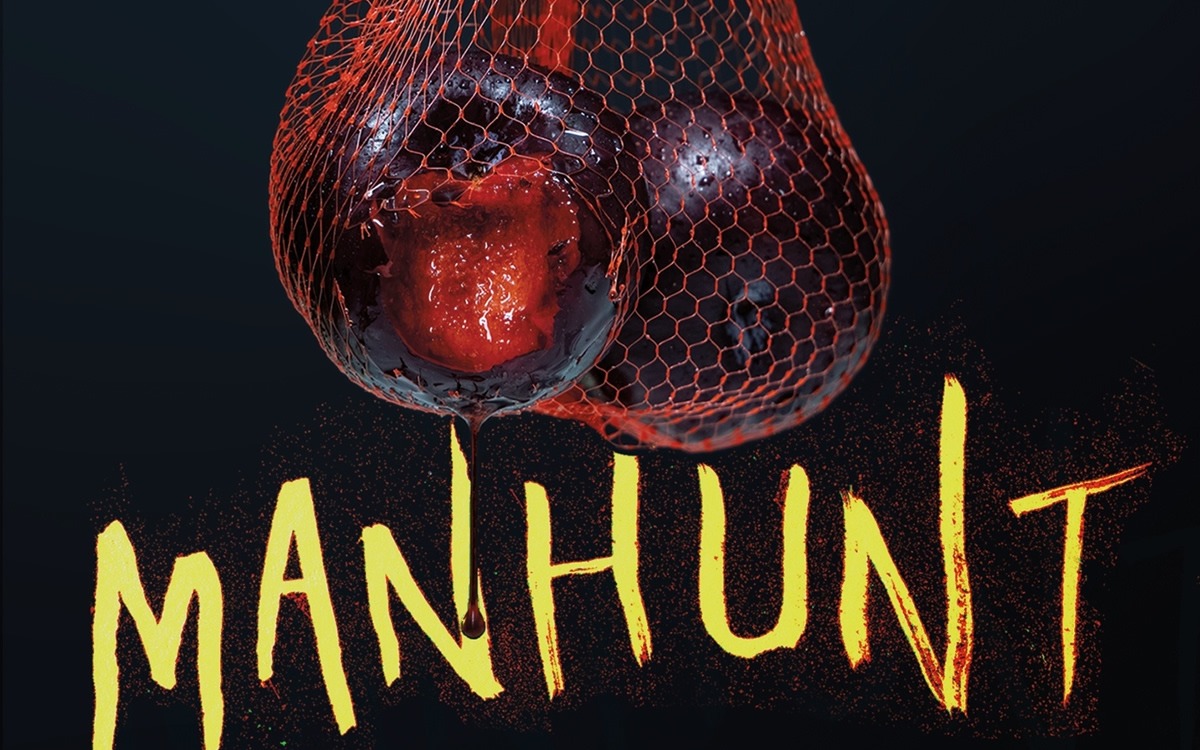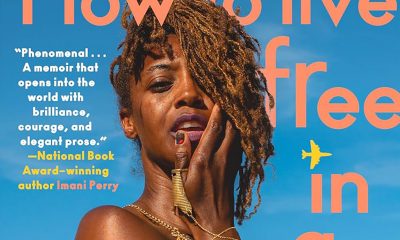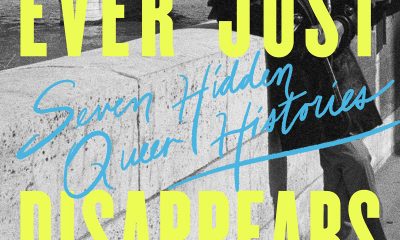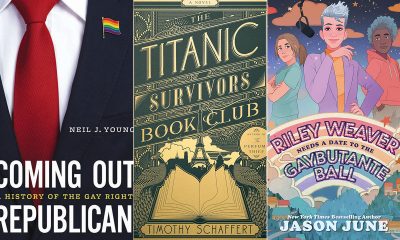Books
Best fiction, nonfiction reads for your winter pleasure
11 picks sure to keep you riveted

It happens every year.
The decorations come down. The last of the Christmas leftovers have been eaten. Errant bits of ripped wrapping are found and discarded. You have no more holiday candy or cookies, you look around at your empty hands, and you wonder now what?
Now it’s time to settle in and read for the rest of the winter season. For your pleasure, here are the Top Five Bookworm Picks for the Best of 2022.
Fiction
Lovers of fairy tales are in for a big surprise with “The Book Eaters“ by Sunyi Dean (Tor, $26.99). It’s a dark, dark legend filled with evil dragons that look like men, princesses that are worse than second-class citizens within their realms, and a chase that will chill you. Book lovers will adore this tale, especially if you don’t necessarily need a happily-ever-after.
Pick up a copy of “Dot and Ralphie“ by Amy Hoffman (University of Wisconsin Press, $16.95) and it doesn’t look like much. But aren’t you glad you don’t judge a book by its cover? This is a sweet tale of two elderly women, partners in life and love, and aging. It’s sweet and grumpy and charming, somewhat like a lesbian Honeymooners episode, only better.
Readers who are familiar with the thrillers that James Lee Burke writes will absolutely be stunned by “Every Cloak Rolled in Blood“ (Simon & Schuster, $27) because in this book, the thrill is secondary to the main plot. Here, retired detective Aaron Broussard has lost his beloved daughter and it’s cut him to the core. Fiery, glass-sharp grief doesn’t stop crime, though, and so he still has crime to solve – whether real, or imagined. Read this book with an open heart and tissues at hand. It may be Burke’s best.
Lovers of clever, clever stories will love “Sign Here“ by Claudia Lux (Berkeley, $27). It’s the tale of Peyote Trip, whose job on the Fifth Floor of Hell is to recruit new souls for eternity. But Pey has a plan to get out of his purgatory, which turns this funny, sharp-witted story into a shady mystery that will make you laugh a lot and squirm even more.
Here’s a book that’s absolutely not for everyone: “Manhunt“ by Gretchen Felker-Martin (Macmillan Nightfire, $17.99) is a lesbian feminist dystopian thriller, which sounds like a lot and it is. A virus has hit every corner of the world, making men into wolf-like killing machines and sending the women into hiding. When two young women – one of them, trans – learns that a “healer” might be able to save her from the inevitable, they head out to find the woman but a makeshift band of warrior women get in their way. Again, this isn’t a book for everyone but if you’re looking for something very, very different, this is it.
BONUS: “Things Past Telling“ by Sheila Williams (Amistad, $25.99) is a novel of the memories of a 112-year-old former slave, who was also a pirate’s woman, a healer, and someone reaching for things her soul needed. It’s an adventurous book with the tiniest touch of fantasy and you shouldn’t miss it.
Non-Fiction
You have questions. And “All the Living and the Dead“ by Hayley Campbell (St. Martin’s Press, $29.99) has answers. When someone dies, what happens next? A wide variety of things, that’s what, and it’s someone else’s job to see that it’s done right. This book is careful not to be (too) gruesome but it is compellingly fascinating.
“Charlie’s Good Tonight” by Paul Sexton (Harper, $27.99) is on this list because it could be the biggest surprise of the year for readers. It’s the story of the late Rolling Stones drummer Charlie Watts, a man who really never wanted fame and often actively shunned the limelight. If you think you know all about the debauchery of your favorite rock ‘n roll band, think again and be totally charmed by one man’s life.
There are two business books on this list because they don’t at all read like business books; in fact, “Think Like a Horse“ by Grant Golliher (Putnam, $28) and “Meet Me by the Fountain“ by Alexandra Lange (Bloomsbury, $28) both seem more like snuggle-up-in-front-of-the-fire kinds of books. Golliher’s book is pure cowboy – he was a rancher and worked extensively with horses – and there are western-novel tones in his book on getting the most out of people. Lange’s book is a trip to the mall throughout history, including a good look at stores you may have visited through the years. These books are both great for the business-minded reader, but could be enjoyed by anyone.
And finally, an obsession: “To Walk About in Freedom“ by Carole Emberton (W.W. Norton, $28.95) is a jaw-dropping memoir that hides in a history book. In the earlier part of the last century, the government paid writers to interview people for a WPA project. One of the interviewees was a former slave woman who offers up not only her life, but a real-life account of the end of slavery and how it impacted everyday, average people. This is a book you’ll be talking about well into the new year.
If these 11 books don’t fit your mood, then be sure to check with your favorite bookseller or librarian. When it comes to books, (s)he is a superhero.
Happy reading!
The Blade may receive commissions from qualifying purchases made via this post.
Books
New book offers observations on race, beauty, love
‘How to Live Free in a Dangerous World’ is a journey of discovery

‘How to Live Free in a Dangerous World: A Decolonial Memoir’
By Shayla Lawson
c.2024, Tiny Reparations Books
$29/320 pages
Do you really need three pairs of shoes?
The answer is probably yes: you can’t dance in hikers, you can’t shop in stilettos, you can’t hike in clogs. So what else do you overpack on this long-awaited trip? Extra shorts, extra tees, you can’t have enough things to wear. And in the new book “How to Live Free in a Dangerous World” by Shayla Lawson, you’ll need to bring your curiosity.

Minneapolis has always been one of their favorite cities, perhaps because Shayla Lawson was at one of Prince’s first concerts. They weren’t born yet; they were there in their mother’s womb and it was the first of many concerts.
In all their travels, Lawson has noticed that “being a Black American” has its benefits. People in other countries seem to hold Black Americans in higher esteem than do people in America. Still, there’s racism – for instance, their husband’s family celebrates Christmas in blackface.
Yes, Lawson was married to a Dutch man they met in Harlem. “Not Haarlem,” Lawson is quick to point out, and after the wedding, they became a housewife, learned the language of their husband, and fell in love with his grandmother. Alas, he cheated on them and the marriage didn’t last. He gave them a dog, which loved them more than the man ever did.
They’ve been to Spain, and saw a tagline in which a dark-skinned Earth Mother was created. Said Lawson, “I find it ironic, to be ordained a deity when it’s been a … journey to be treated like a person.”
They’ve fallen in love with “middle-American drag: it’s the glitteriest because our mothers are the prettiest.” They changed their pronouns after a struggle “to define my identity,” pointing out that in many languages, pronouns are “genderless.” They looked upon Frida Kahlo in Mexico, and thought about their own disability. And they wish you a good trip, wherever you’re going.
“No matter where you are,” says Lawson, “may you always be certain who you are. And when you are, get everything you deserve.”
Crack open the front cover of “How to Live Free in a Dangerous World” and you might wonder what the heck you just got yourself into. The first chapter is artsy, painted with watercolors, and difficult to peg. Stick around, though. It gets better.
Past that opening, author Shayna Lawson takes readers on a not-so-little trip, both world-wide and with observant eyes – although it seems, at times, that the former is secondary to that which Lawson sees. Readers won’t mind that so much; the observations on race, beauty, love, the attitudes of others toward America, and finding one’s best life are really what takes the wheel in this memoir anyhow. Reading this book, therefore, is not so much a vacation as it is a journey of discovery and joy.
Just be willing to keep reading, that’s all you need to know to get the most out of this book. Stick around and “How to Live Free in a Dangerous World” is what to pack.
The Blade may receive commissions from qualifying purchases made via this post.
Books
Story of paralysis and survival features queer characters
‘Unswerving: A Novel’ opens your eyes and makes you think

‘Unswerving: A Novel’
By Barbara Ridley
c.2024, University of Wisconsin Press
$19.95 / 227 pages
It happened in a heartbeat.
A split-second, a half a breath, that’s all it took. It was so quick, so sharp-edged that you can almost draw a line between before and after, between then and now. Will anything ever be the same again? Perhaps, but maybe not. As in the new book “Unswerving” by Barbara Ridley, things change, and so might you.

She could remember lines, hypnotizing yellow ones spaced on a road, and her partner, Les, asleep in the seat beside her. It was all so hazy. Everything Tave Greenwich could recall before she woke up in a hospital bed felt like a dream.
It was as though she’d lost a month of her life.
“Life,” if you even wanted to call it that, which she didn’t. Tave’s hands resembled claws bent at the wrist. Before the accident, she was a talented softball catcher but now she could barely get her arms to raise above her shoulders. She could hear her stomach gurgle, but she couldn’t feel it. Paralyzed from the chest down, Tave had to have help with even the most basic care.
She was told that she could learn some skills again, if she worked hard. She was told that she’d leave rehab some day soon. What nobody told her was how Les, Leslie, her partner, girlfriend, love, was doing after the accident.
Physical therapist Beth Farringdon was reminded time and again not to get over-involved with her patients, but she saw something in Tave that she couldn’t ignore. Beth was on the board of directors of a group that sponsored sporting events for disabled athletes; she knew people who could serve as role models for Tave, and she knew that all this could ease Tave’s adjustment into her new life. It was probably not entirely in her job description, but Beth couldn’t stop thinking of ways to help Tave who, at 23, was practically a baby.
She could, for instance, take Tave on outings or help find Les – even though it made Beth’s own girlfriend, Katy, jealous.
So, here’s a little something to know before you start reading “Unswerving”: author Barbara Ridley is a former nurse-practitioner who used to care for patients with spinal cord injuries. That should give readers a comfortable sense of satisfaction, knowing that her experiences give this novel an authenticity that feels right and rings true, no faking.
But that’s not the only appeal of this book: while there are a few minor things that might have readers shaking their heads (HIPAA, anyone?), Ridley’s characters are mostly lifelike and mostly likable. Even the nasties are well done and the mysterious character that’s there-not-there boosts the appeal. Put everyone together, twist a little bit to the left, give them some plotlines that can’t ruined by early guessing, and you’ve got a quick-read novel that you can enjoy and feel good about sharing.
And share you will because this is a book that may also open a few eyes and make readers think. Start “Unswerving” and you’ll (heart) it.
The Blade may receive commissions from qualifying purchases made via this post.
Books
Examining importance of queer places in history of arts and culture
‘Nothing Ever Just Disappears’ shines with grace and lyrical prose

‘Nothing Ever Just Disappears: Seven Hidden Queer Histories’
By Diarmuid Hester
c.2024, Pegasus Books
$29.95/358 pages
Go to your spot.
Where that is comes to mind immediately: a palatial home with soaring windows, or a humble cabin in a glen, a ramshackle treehouse, a window seat, a coffeehouse table, or just a bed with a special blanket. It’s the place where your mind unspools and creativity surges, where you relax, process, and think. It’s the spot where, as in the new book “Nothing Ever Just Disappears” by Diarmuid Hester, you belong.

Clinging “to a spit of land on the south-east coast of England” is Prospect Cottage, where artist and filmmaker Derek Jarman lived until he died of AIDS in 1994. It’s a simple four-room place, but it was important to him. Not long ago, Hester visited Prospect Cottage to “examine the importance of queer places in the history of arts and culture.”
So many “queer spaces” are disappearing. Still, we can talk about those that aren’t.
In his classic book, “Maurice,” writer E.M. Forster imagined the lives of two men who loved one another but could never be together, and their romantic meeting near a second-floor window. The novel, when finished, “proved too radical even for Forster himself.” He didn’t “allow” its publication until after he was dead.
“Patriarchal power,” says Hester, largely controlled who was able to occupy certain spots in London at the turn of the last century. Still, “queer suffragettes” there managed to leave their mark: women like Vera Holme, chauffeur to suffragette leader Emmeline Pankhurst; writer Virginia Woolf; newspaperwoman Edith Craig, and others who “made enormous contributions to the cause.”
Josephine Baker grew up in poverty, learning to dance to keep warm, but she had Paris, the city that “made her into a star.” Artist and “transgender icon” Claude Cahun loved Jersey, the place where she worked to “show just how much gender is masquerade.” Writer James Baldwin felt most at home in a small town in France. B-filmmaker Jack Smith embraced New York – and vice versa. And on a personal journey, Hester mourns his friend, artist Kevin Killian, who lived and died in his beloved San Francisco.
Juxtaposing place and person, “Nothing Ever Just Disappears” features an interesting way of presenting the idea that both are intertwined deeper than it may seem at first glance. The point is made with grace and lyrical prose, in a storyteller’s manner that offers back story and history as author Diarmuid Hester bemoans the loss of “queer spaces.” This is really a lovely, meaningful book – though readers may argue the points made as they pass through the places included here. Landscapes change with history all the time; don’t modern “queer spaces” count?
That’s a fair question to ask, one that could bring these “hidden” histories full-circle: We often preserve important monuments from history. In memorializing the actions of the queer artists who’ve worked for the future, the places that inspired them are worth enshrining, too.
Reading this book may be the most relaxing, soothing thing you’ll do this month. Try “Nothing Ever Just Disappears” because it really hits the spot.
The Blade may receive commissions from qualifying purchases made via this post.
-

 District of Columbia3 days ago
District of Columbia3 days agoCatching up with the asexuals and aromantics of D.C.
-

 State Department5 days ago
State Department5 days agoState Department releases annual human rights report
-

 South America3 days ago
South America3 days agoArgentina government dismisses transgender public sector employees
-

 Maine4 days ago
Maine4 days agoMaine governor signs transgender, abortion sanctuary bill into law












